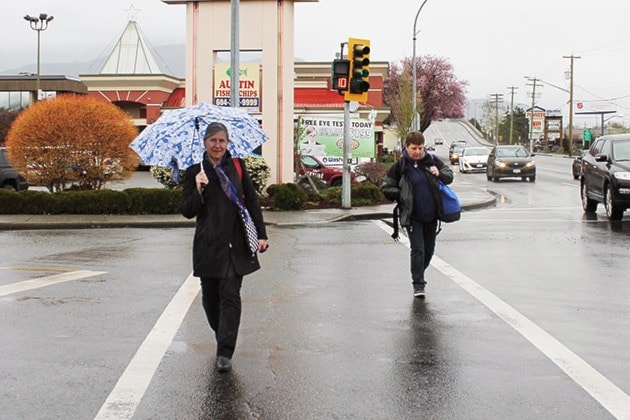We've all been there.
You're waiting to walk at an intersection, and you take an uncertain step only to realize drivers turning left have an advanced green light. Or, you're delayed to leave a curb and rush to reach the other side before oncoming traffic heads your way.
It's nerve-racking for pedestrians and drivers alike. Even more so if you're blind or partially sighted.
On her daily walk to and home from work at the Chilliwack Learning Society, Debbie Denault would encounter a similar struggle.
Due to optic nerve damage, Debbie's vision is 20 over 200. That puts her in the range of legal blindness.
She'd push the walk button and observe traffic patterns as best she could. But her limited vision makes it difficult to see the walk sign, and the intersections on her route have volume-dependent traffic patterns.
Valuable time would be lost each day as she determines whether or not it's her turn to cross, often leaving her in the line of traffic.
"It's a bit daunting when that happens," Debbie pointed out.
It got to the point where she'd become stressed out when it came time to head out to a meeting.
"All I really want to do is cross the road," she said, laughing at how seemingly simple the task should be.
That's why audible pedestrian signals are so important. That cuckoo or chirp provides the assurance and peace-of-mind for those who have difficulty seeing the walk sign.
The City of Chilliwack pedestrian safety program includes the ongoing installation of audible traffic signals. It costs about $8,000 to update a standard eight-phase intersection with the accessible equipment.
The City budgets for a minimum of one or two intersections added each year. They've upgraded 20 intersections across Chilliwack thus far, with seven more proposed for 2016.
Project managers rely on individual intersection requests from pedestrians, as well as the added guidance from the Canadian National Institute for the Blind (CNIB) and the White Cane Club.
Karli Murton, an Orientation and Mobility Specialist with CNIB, met with Debbie last year to take spend a day in her shoes.
The two walked back and forth across Debbie's proposed intersections at Yale and Hocking and Yale and Airport. Karli helped Debbie to better understand the changing traffic patterns, and she assessed the area to determine its priority.
The high-volume intersections are near a middle school, retirement homes, public transit routes, and many business amenities. Combined with the fact that turning traffic doesn't always follow a predicable sequence, Murton concluded that audible signals would be greatly beneficial to all pedestrians in the vicinity, sighted or blind. She provided that feedback to the city.
As Debbie embarked on her walk to work in early January, she pressed the walk button like she always does, wearing her sunglasses to reduce the sun's glare.
"I heard the beep," she said. "And I cried all the way across the street."
Much to her appreciation, the City had installed audible traffic signals at both intersections that she requested over the holiday break.
Though it varies in some communities, the added speakers will ring out a two-tone cuckoo sound for North-South crossings, or a one-tone chirp that indicates an East-West crossing.
“It is important for us to plan ahead to ensure that our city is truly accessible to people with disabilities. We are grateful to work with individuals and community groups to set our priorities,” said Mayor Sharon Gaetz.
The Mayor joined Debbie as she celebrated the new installations with a 'Celebration of Lights' walk and informal ribbon cutting ceremony earlier this month with friends and family.
"Although I know I still need to be careful, I'm much more confident. Much more comfortable," Debbie said of her daily commute to work, enjoying the benefits of the upgraded signals.
"It's such a gift. I'm so grateful."
Visit clearingourpath.ca for more information about CNIB services and recommendations for accessible community design.
Visit chilliwack.ca to learn more about signals and the audible pedestrian program.

